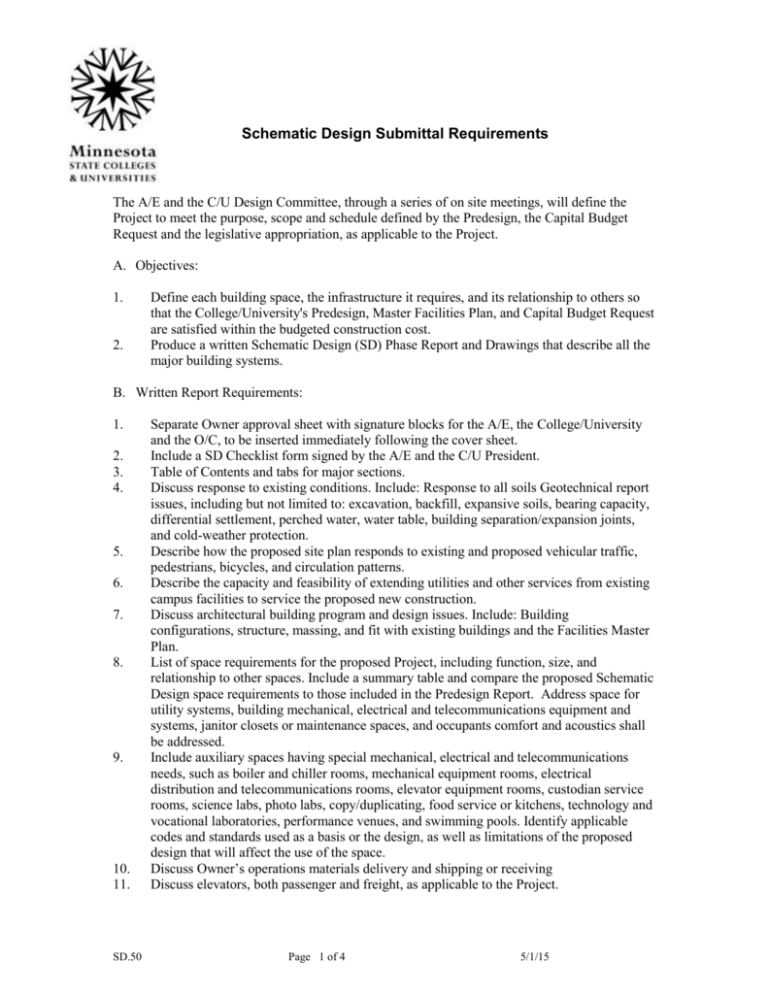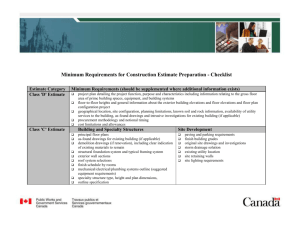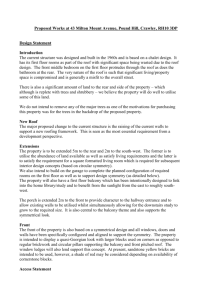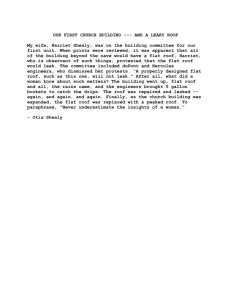Schematic Design Submittal Requirements
advertisement

Schematic Design Submittal Requirements The A/E and the C/U Design Committee, through a series of on site meetings, will define the Project to meet the purpose, scope and schedule defined by the Predesign, the Capital Budget Request and the legislative appropriation, as applicable to the Project. A. Objectives: 1. 2. Define each building space, the infrastructure it requires, and its relationship to others so that the College/University's Predesign, Master Facilities Plan, and Capital Budget Request are satisfied within the budgeted construction cost. Produce a written Schematic Design (SD) Phase Report and Drawings that describe all the major building systems. B. Written Report Requirements: 1. 2. 3. 4. 5. 6. 7. 8. 9. 10. 11. SD.50 Separate Owner approval sheet with signature blocks for the A/E, the College/University and the O/C, to be inserted immediately following the cover sheet. Include a SD Checklist form signed by the A/E and the C/U President. Table of Contents and tabs for major sections. Discuss response to existing conditions. Include: Response to all soils Geotechnical report issues, including but not limited to: excavation, backfill, expansive soils, bearing capacity, differential settlement, perched water, water table, building separation/expansion joints, and cold-weather protection. Describe how the proposed site plan responds to existing and proposed vehicular traffic, pedestrians, bicycles, and circulation patterns. Describe the capacity and feasibility of extending utilities and other services from existing campus facilities to service the proposed new construction. Discuss architectural building program and design issues. Include: Building configurations, structure, massing, and fit with existing buildings and the Facilities Master Plan. List of space requirements for the proposed Project, including function, size, and relationship to other spaces. Include a summary table and compare the proposed Schematic Design space requirements to those included in the Predesign Report. Address space for utility systems, building mechanical, electrical and telecommunications equipment and systems, janitor closets or maintenance spaces, and occupants comfort and acoustics shall be addressed. Include auxiliary spaces having special mechanical, electrical and telecommunications needs, such as boiler and chiller rooms, mechanical equipment rooms, electrical distribution and telecommunications rooms, elevator equipment rooms, custodian service rooms, science labs, photo labs, copy/duplicating, food service or kitchens, technology and vocational laboratories, performance venues, and swimming pools. Identify applicable codes and standards used as a basis or the design, as well as limitations of the proposed design that will affect the use of the space. Discuss Owner’s operations materials delivery and shipping or receiving Discuss elevators, both passenger and freight, as applicable to the Project. Page 1 of 4 5/1/15 Discuss the C/U’s Furniture/Fixtures and Equipment (FF&E) requirements. Describe plans to complete the definition, design, procurement and installation of all FF&E. 12. C. Discuss Major Building Systems. Include: 1. Description of proposed architectural exterior elevations, walls, partitions, roofs, major structural, mechanical (plumbing, fire protection, HVAC and temperature controls) and electrical (lighting, power, fire alarm, security, and telecommunications) systems. 2. Provide basic design parameters for mechanical and electrical systems. Include mechanical design temperature criteria for various building zones by season and power and lighting systems design criteria. 3. Report areas within the proposed construction work area that are known or suspected to contain asbestos, based on review of any applicable asbestos survey reports. Inquire and account for abatement time in the overall Project design and construction schedules. 4. Describe floor to floor, floor-to-ceiling and floor-to-structure clearances related to architectural, structural, mechanical, electrical, and other building system requirements. Certify that ceiling heights and mechanical room spaces are sufficient for installation and service of equipment, corresponding piping, ductwork, and conduit. D. Discuss Project Schedule and Costs. Include: 1. The Project Schedule from the start of design through bidding, construction and Owner occupancy. Include times in the Schedule for Schematic Design, Design Development, and Construction Documents Owner reviews and approvals. The Project Schedule must be reflective of the C/U’s Project Schedule maintained in Unifier. 2. Statement of estimated construction cost broken down by the CSI Master Format, 49 divisions. The estimate of construction must be reflective of C/U’s budget maintained in Unifier. 3. Provide a Project schedule in bar chart form and include milestone dates. Coordinate Schedule dates with the C/U’s academic schedule. E. Include a Quality Assurance Plan for all testing, observation, and quality control needed for the Project. Use the standard chart format supplied by the Owner. F. Include written copies of the Design Standards Variance Requests for all variance requests, which have been forwarded to date to the O/C Program Manager. G. Include the following in appendices: 1. 2. 3. 4. List of all applicable codes and standards and the currently applicable edition dates. A copy of the Geotechnical investigation(s) Report. A copy of the complete Schematic Design Construction Cost Estimate. Documentation of preliminary review meetings and discussions with the state and local building code officials and the local fire marshal. H. Drawing Requirements: 1. General: All plan drawings shall have north arrows and all drawings shall have scale indicated. Minimum 1/8" scale of all areas, ¼" for areas where clearances are critical, i.e. bathrooms, toilets, stairs and mechanical rooms. SD.50 Page 2 of 4 5/1/15 2. Drawing Sizes - Submit Schematic Design drawings for initial review in full size format. Final submittal for the Schematic Design Report shall be 11" x 17" Drawings folded into 8.5” x 11” size bound at the end of the written report. Full size sheets are also required for the Owner and the Owner’s consultants to review, as applicable to the Project. 3. Title Sheet - Include the names of the A/E design team and all consulting firms involved in the Project, an Index of Drawings, preliminary code analysis, and building statistics (number of floors, GSF/floor, total GSF, roof area, and building height(s), summarized separately for remodeled and new areas). 4. Existing Site Survey - Include a copy of all site boundary and topographic property surveys, provided by others. 5. Site Plan a. Provide site plans showing utility connections, routings, sewage systems, and storm drains. Show where existing utilities will be relocated beyond the new construction structural loading zones. b. Include north arrow, construction limits, sidewalks, streets, parking lots, handicapped access, landscaped areas, contours, drainage, grading characteristics, and utilities, utility tunnels. Show relationship of new to existing. 6. Architectural Floor Plan Drawings - Identify room functions. Provide separate furniture and equipment floor Layouts Plans to scale, as applicable. Clearly illustrate access, including handicapped and exiting. Provide preliminary demolition plans. 7. Roof Plan Drawings a. Indicate all roof areas affected by the proposed Project. b. Indicate drainage (high and low points of roof membrane surface and slopes); identify drains and overflows; and show roof access and roof mounted equipment expected, roof control joints, roof expansion joints, roof penetrations, and roof curbs. c. Show fresh air intakes and building exhaust locations. 8. Exterior Elevations a. Illustrate exterior wall features, dimensions, materials, control joints, expansion joints, and relationship to existing structures. b. Show fresh air intake locations in relation to building exhaust, auto exhaust, cooling towers, loading docks and other pollutant sources. Show air intake elevations and their relation to grade. 9. Major Building Sections - Include a least one transverse and one longitudinal building cross section through the key proposed new building areas. 10. Wall Sections and Other Details - Illustrate foundations, primary structural systems, principle wall constructions (including thru-wall flashings), waterproofing, roof systems, vapor barriers, interior partitions, exterior doors and windows. Show wall details at not less than 3"=1’-0” scale. Provide 3"=1’-0” scale isometric details of all non-right angle and curved construction elements. 11. Mechanical and Electrical Drawings - Provide schematic layout of mechanical equipment and rooms, showing adequate space for general access and for removal, repair, and maintenance. 12. Provide preliminary HVAC ductwork system floor plans. Include locations of outside air supply air and exhaust air locations in conjunction with each other, loading dock vent lines, engine exhaust stacks, plumbing vents, exhaust fans, and other contamination sources. 13. Show the locations of all major mechanical and electrical systems equipment, pumps, boilers, chillers, expansion tanks, heat exchangers, water heaters, energy recovery units, cooling towers, transformers, switchgear, generators, elevator equipment, etc. SD.50 Page 3 of 4 5/1/15 14. Provide preliminary electrical, lighting, power and systems floor plans. SD.50 Page 4 of 4 5/1/15






